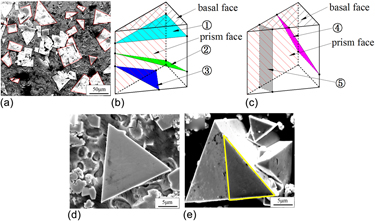Crossref Citations
This article has been cited by the following publications. This list is generated based on data provided by
Crossref.
Yuan, Youlu
and
Li, Zhuguo
2017.
Microstructure and tribology behaviors of in-situ WC/Fe carbide coating fabricated by plasma transferred arc metallurgic reaction.
Applied Surface Science,
Vol. 423,
Issue. ,
p.
13.
Yuan, Youlu
and
Li, Zhuguo
2017.
A novel approach of in-situ synthesis of WC particulate-reinforced Fe-30Ni ceramic metal coating.
Surface and Coatings Technology,
Vol. 328,
Issue. ,
p.
256.
Zhong, Lisheng
Deng, Chao
Zhang, Xi
Bai, Haiqiang
Zhu, Jianlei
Lu, Zhengxin
and
Xu, Yunhua
2019.
WC-Fe layer with high volume fraction and fracture toughness on cast iron fabricated by in situ solid-phase diffusion.
Vacuum,
Vol. 168,
Issue. ,
p.
108801.
Shu, Da
Dai, Sichao
Wang, Gang
Si, Wudong
Xiao, Ping
Cui, Xiangxiang
and
Chen, Xu
2020.
Influence of CeO2 content on WC morphology and mechanical properties of WC/Ni matrix composites coating prepared by laser in-situ synthesis method.
Journal of Materials Research and Technology,
Vol. 9,
Issue. 5,
p.
11111.
Lv, Xiangzhe
Zhan, Zaiji
and
Cao, Haiyao
2022.
Microstructure Evolution and Mechanical Properties of Needle-like ZrB2 Reinforced Cu Composites Manufactured by Laser Direct Energy Deposition.
Micromachines,
Vol. 13,
Issue. 2,
p.
212.
Shabalin, Igor L.
2022.
Ultra-High Temperature Materials IV.
p.
11.
Eryomina, M.A.
Lomayeva, S.F.
Kharanzhevsky, E.V.
and
Bel'tyukov, A.N.
2022.
Wear-resistant coatings produced by high-speed selective laser sintering of wet-milled W Fe powders: Phase composition, microstructure, and properties.
International Journal of Refractory Metals and Hard Materials,
Vol. 108,
Issue. ,
p.
105915.
Lee, Woo-Jin
Kim, Eun-Ah
Woo, Yeong-Jin
Park, Ihho
Yu, Ji-Hun
Ha, Taeho
Choi, Yoon Suk
and
Lee, Hak-Sung
2022.
Effect of different WC particle shapes on laser-exposed microstructures during the directed energy deposition.
Powder Metallurgy,
Vol. 65,
Issue. 1,
p.
22.
Jilabi, Abdul Sameea Jasim Abdul Zehra
and
Alakal, Hawraa Najim Abdoun
2023.
A review on laser and TIG cladding of WC-Ni composite on steel alloys.
Vol. 2977,
Issue. ,
p.
040095.
Al-Thamir, Mohaimen
Algodi, Samer J.
Al-Hamdani, Kamaal S.
and
Abed, Aqeel A.
2024.
The effect of nominal powder thickness on solidification behavior of atypical multilayer WC–Co components fabricated by laser-powder bed fusion.
Progress in Additive Manufacturing,
Vol. 9,
Issue. 2,
p.
237.
